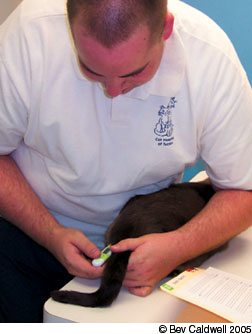Ever wonder why your cat feels hot to the touch? Cats normally have a temperature several degrees higher than ours. And knowing how to take a cats temperature is a very good skill to possess.

252
When you think your cat may be ill, calling the veterinarian with your cats temperature can help the doctor to figure out what is going on. And if you are treating your cat for an illness or wound, you may need to keep track of your cats temperature to see if the treatment is working.
What an Elevated Temperature Means
A cats normal temperature is between 100 and 102.5 degrees F or 37.7 and 39.4 C. (Kittens may have a slightly higher temperature than adult cats.) An elevated temperature usually indicates an infection or some other condition, such as autoimmune disease or an endocrine disorder. But a high temperature can also be caused by drug reactions, fear, trauma – and even a lot of exercise. If your cat is frightened while you take his temperature, it can easily go up to 103 degrees F.
I recommend that cat breeders check their females temperature, says Joann Young, DVM, who specializes in felines in her private practice in Dover, New Hampshire, because the queens temperature will drop right before she goes into labor.
If you are monitoring your cats temperature, take it at least twice a day, because there are normal fluctuations throughout the day. Usually, the cats temperature is lowest in the morning and rises in the afternoon and evening. Therefore, to track your cats temperature, take it in the morning and the evening. A temperature of 105 degrees is serious, and you should contact a veterinarian immediately. If you get a reading of between 103 and 104.5 degrees, seek advice from your veterinarian.
Preparing for Taking the Temperature
The process will seem a lot less daunting if you assemble all your supplies beforehand on your kitchen counter.
First, you need a human rectal thermometer. A digital thermometer is better because it is easier to read than the mercury types. Its also much faster and safer than a mercury thermometer, says Dr. Young. So it may be well worth it to invest in a digital thermometer.
If the thought of taking your cats temperature rectally leaves you queasy, you may want to consider an ear thermometer made especially for cats. This type of thermometer measures the infrared heat waves from the eardrum region and provides a reading of your cats core body temperature in one second. It does take a bit of practice to insert it correctly into your cats ear.
However, says Dr. Young, many cats have hair in their ears that may interfere with the readings accuracy by up to two degrees. According to Dr. Young, a rectal reading is more accurate than a reading by ear. Therefore, a temperature of 101 degrees F taken by ear may actually read as 103 degrees F taken rectally. And this could indicate a fever, says Dr. Young.
Never attempt to insert an oral thermometer into a cats mouth. A cat will naturally bite down on anything placed in her jaws, and the results can be disastrous with a glass and mercury thermometer.
Other items you may need – depending on the type of thermometer you use – include a petroleum jelly like Vaseline or a water-based lubricant like K-Y jelly, a watch or clock with a second hand or a timer, and a towel. One of the most important things to have on hand is an assistant to help you hold and comfort your cat while you take her temperature.
The Procedure
Place your cat on the kitchen counter or a table so that the cat is at your waist level, which will make the process easier for you. Assuming you have an assistant, let your helper gently restrain your cat on the counter. If you are alone, it may be a good idea to wrap your cat in a towel with the cats head and rear end exposed.
Next, shake the mercury thermometer down to 96 degrees F, or reset the digital thermometer. Lubricate the thermometer, then lift the cats tail with one hand while inserting the thermometer slowly and steadily into the anus with the other. Go only to a depth of a half inch to one inch maximum.
At first, you will feel her sphincter muscle tighten, and then relax. If you are using a mercury thermometer, hold the thermometer there for two minutes. A digital thermometer will beep when it has obtained a reading. Talk softly to your cat while you are taking her temperature.
Most cats will want to put down their tail after youve inserted the thermometer, says Dr. Young. And you should let them do this because they will feel so much more comfortable.
Remove the thermometer and record the temperature. Writing the temperature down is very important, because you may be taking several readings over the course of a couple of days. When you are finished with the thermometer, rinse it well with warm water and disinfectant soap. (Some thermometers come with one-time-use covers.)
After the whole process is done, try to comfort and praise your cat. By doing this, you will reassure her that you know what you are doing – even if its the first time you have ever taken a cats temperature.



